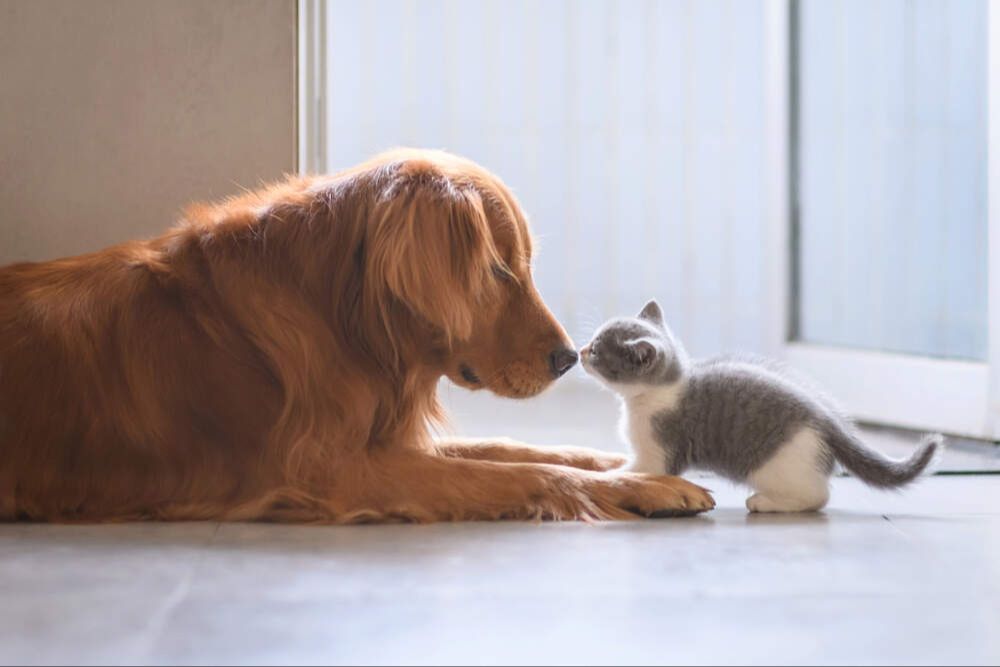Introduction
Raising both kittens and dogs together can be extremely rewarding, but it’s important to properly introduce them to ensure they get along safely. This article provides a comprehensive overview of whether kittens and dogs can coexist in harmony, and the steps owners should take when introducing a new kitten to dogs.
The purpose of this article is to educate owners on best practices for safely and successfully introducing kittens to dogs. Proper introductions allow dogs and cats to build positive relationships from the start, reducing stress and anxiety for both pets. With patience, supervision, and care, kittens and dogs can become lifelong companions.
While some dogs have strong prey drives towards cats, many breeds have friendly, gentle temperaments compatible with kittens. By taking precautions and slowly acclimating the animals, owners can facilitate peaceful coexistence. This article will provide background on dog and kitten behavior, outline a step-by-step introduction process, and offer safety tips for ongoing interactions.
Dog Breeds and Kittens
Certain dog breeds are known to be especially good with kittens. Some recommended breeds include:

Golden Retrievers – Known for their friendly, gentle temperament. Golden Retrievers tend to get along well with other animals (source).
Labrador Retrievers – Labrador Retrievers are outgoing and kind. They are eager to get along with everyone, including cats and kittens (source).
Cavalier King Charles Spaniels – This breed is playful, patient and gentle, making them one of the best dog breeds for homes with cats (source).
Some breeds that may not be the best with kittens include:
Jack Russell Terriers – With a strong prey drive, these energetic dogs may be too much for kittens (source).
Dalmatians – Dalmatians can have a high prey drive and may get overly excited around kittens (source).
Dachshunds – Stubborn and energetic, Dachshunds may not have the patience for kittens (source).
Dog and Kitten Temperaments

The temperaments of both dogs and kittens can vary greatly between individuals. When considering introducing a dog to a new kitten, it’s important to take their personalities into account.
Some dogs have a very high prey drive and may view a small, quick kitten as something to chase. Dogs that are highly playful and excitable can also overwhelm a kitten unintentionally with their enthusiasm. According to the ASPCA, dogs with strong predatory instincts like terriers, herding breeds, and sporting breeds may be more likely to give chase (1).
Conversely, laid-back or gentle dog breeds like retrievers, bulldogs, or spaniels may interact better with kittens. The dog’s age, previous exposure to cats, and training will also impact its behavior around kittens.
Kittens can have shy, fearful personalities or be quite outgoing and bold. Shy kittens may be intimidated by dogs and require gradual positive associations. Outgoing kittens may be overly curious, approaching dogs without fear. Supervision is key to ensure play does not become too rough.
Slow introductions over multiple days or weeks allow dogs and kittens time to become comfortable with each other’s presence, smells, and sounds. This can pave the way for safe, friendly interactions once the kitten is a bit older.
(1) https://www.aspca.org/pet-care/cat-care/cats-and-dogs
Introducing Dogs and Kittens
When initially introducing a dog and a kitten, it’s important to go slowly and watch for signs of stress. Some tips for the initial introduction include:
- Keep the dog on a leash and allow the kitten to approach at her own pace (Animal Human Society, https://www.animalhumanesociety.org/resource/how-introduce-dog-and-cat). This allows the kitten to feel in control of the situation.
- Give both pets treats and praise for calm behavior (Animal Human Society, https://www.animalhumanesociety.org/resource/how-introduce-dog-and-cat). This creates a positive association with the other animal.
- Separate the animals if either acts aggressively or fearful. Try again in a little while after letting them calm down (Comfort Zone, https://www.comfortzone.com/behavior-blog/multi-pet-behavior/how-to-introduce-your-new-kitten-to-your-dog). Don’t force interactions.

Signs of stress to watch for include hissing, growling, swatting, a tucked tail, ears back, hiding, or trembling. If you see these, separate the pets immediately and try again later in a more controlled manner. Use positive reinforcement, like treats and praise, to encourage polite interactions. With time and patience, the dog and kitten can become comfortable with each other.
Supervised Interactions
It is very important that all interactions between dogs and kittens be closely supervised, especially during the initial introduction period. This allows the pet owner to immediately correct any unwanted behaviors that could lead to conflict or trauma.
Any signs of aggression, dominance, or prey drive from the dog towards the kitten should be corrected through verbal commands or distraction techniques. Praise and positive reinforcement should be given when the dog remains calm and gentle around the new kitten. Some experts recommend having the dog on a leash during introductions so he can be easily controlled.
Likewise, kittens may initially hiss, swat, or flee when first interacting with a dog. Pet owners should soothe the kitten while preventing any aggressive retaliation from the dog. With time and continued positive associations, the kitten will likely become more comfortable around the dog.
According to the ASPCA, “All interactions between your dog and cat should be closely monitored, and good behaviors reinforced with rewards. If either animal becomes agitated, end the session immediately and try again the following day.”1
Safety Precautions
When introducing a kitten to a home with dogs, it’s important to take safety precautions to avoid injury. Kittens are small, fragile, and unable to defend themselves, so keeping them safe should be the top priority.
Provide the kitten with safe spaces it can access but dogs cannot. Use baby gates or close doors to allow the kitten to have a room to itself. Make sure the kitten has access to food, water, litter box, toys, scratching posts, and resting areas without the dog. High surfaces like cat towers, bookshelves, and windowsills also allow kittens to perch safely above dog level (Security.org).
Keep an eye on all interactions between dogs and kittens. Even play can turn rough, so continuous supervision is a must. If the dog seems overly excited or the kitten distressed, separate them immediately. Proper introduction and supervised acclimation will help avoid risky situations.
Kittens should also have identification. Microchipping is ideal in case the kitten slips out a door unnoticed. Breakaway safety collars with identification tags are also recommended (The Old Farmer’s Almanac). Take steps to keep the kitten securely inside so it does not escape outdoors unsupervised.
With preparation, supervision, and safe spaces, kittens and dogs can safely coexist in the same home.
Feeding Time
When feeding dogs and kittens, it is important to feed them separately to avoid food aggression. According to Rover, dogs and cats need specific nutrients tailored to their dietary needs, so they should eat food formulated for their species. Allowing them to eat each other’s food can lead to nutritional imbalances.
Designating separate feeding areas can prevent possessive behavior at mealtimes. Place the dog’s food bowl in one area of the home, and the kitten’s food bowl in another area out of sight of the dog. This allows both pets to eat comfortably without feeling territorial. Supervise all interactions, especially in the early stages of getting to know each other. With time and positive associations, some dogs and cats can learn to coexist peacefully at mealtimes.
It’s also a good idea to pick up food bowls after mealtimes so there is no opportunity for stealing leftover food. Cats tend to graze throughout the day, so you may need to separate the kitten during your dog’s designated feeding times. Pay close attention and don’t hesitate to intervene at the first sign of food aggression or possessive behavior from either pet.
Sleeping Areas
When introducing a new kitten to a home with dogs, it’s important to provide the kitten with their own safe sleeping space, preferably in a separate room from the dogs at first. As one Redditor advised, kittens should not be put in the same room as dogs unsupervised, as dogs may be able to reach into a kitten’s crate or bed.[1]

Kittens should have their own crate or bed, up on a high surface so they can observe their surroundings safely. Cats naturally like to perch up high when sleeping. Provide stairs or a cat tree so the kitten can climb up to their bed rather than having to jump. Kittens should sleep in a quiet, calm area away from the hustle and bustle of the home.
As the kitten gets older and more accustomed to the dogs, their sleeping areas can be moved closer together. But it’s still ideal to give cats their own space, as they are territorial by nature and need places they can retreat to that feel like their own. With time and proper introductions, many dogs and cats learn to cohabitate peacefully. But always ensure the kitten has a safe, comfortable place to sleep and call their own.
Health Considerations
When raising kittens and dogs together, it’s important to consider preventative health measures to keep both pets happy and healthy. According to PetMD, core vaccines like rabies, distemper, and panleukopenia for kittens and distemper, parvo, and rabies for puppies are essential to prevent dangerous diseases that can be transmitted between species. Kittens and puppies should follow standard vaccine schedules recommended by a veterinarian.
Routine grooming and hygiene is also important. Regular nail trims, baths, dental cleanings, ear checks, and brushings for both kittens and puppies reduces shedding and the spread of parasites like fleas and ticks. Pets should also be routinely dewormed. Proper hygiene and grooming helps prevent the transmission of common illnesses between pets.
According to the CDC, it’s critical to wash your hands after handling pets and their waste to prevent disease transmission. Kittens and dogs should have their own designated food and water bowls. Litter boxes should also be kept clean and away from food preparation areas.
With some basic preventative care and hygiene, kittens and puppies can live together safely and healthily.
Conclusion
In summary, though interactions between kittens and dogs require careful supervision and planning, kittens can generally be safe with dogs. The breed, size, age, temperament, and behavioral tendencies of the dog, the dog’s past interactions with cats, and the temperament and age of the kitten should all be considered. With proper precautions like slow introductions, separation when unsupervised, secure sleeping areas and feeding times, dogs and kittens can co-exist safely under the same roof.
The most important thing is prioritizing the kitten’s safety by never leaving a young kitten alone with a dog. With time, patience, and positive reinforcement during supervised interactions, dogs and kittens can learn to get along and co-habitate peacefully. However, kittens will always require protection since their small size makes them vulnerable. Responsible pet owners must remain vigilant about a kitten’s interactions with dogs in order to prevent any harm.